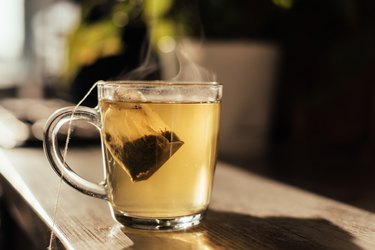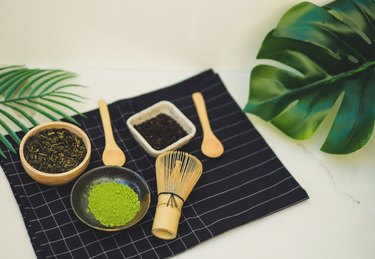
There's a strong debate brewing in the tea community: Should you leave your tea bag in or take it out while drinking? There are advantages to both, but it ultimately comes down to personal preference.
Tea has many health benefits, regardless of whether you leave the tea bag in your cup while you're drinking it. If you want to get technical, follow the recommended brewing times on the package or box of your preferred tea.
Video of the Day
Video of the Day
Here, you'll find info on how to brew the perfect cup of tea and whether or not you should leave your tea bag in your cup.
Tip
Timing is everything. "Steeping for too little time causes weak-tasting tea while steeping for too long will make it bitter," says dietitian Gaby McPherson, RDN.
Whether you remove or leave the tea bag is really up to your personal preference.
How to Make Tea
Making tea is simple and requires just a couple of ingredients and tools. You will need tea, water, a tea kettle and a cup.
You can brew tea from premeasured tea bags, or you can measure out loose-leaf tea and either bag it yourself or use a tea strainer. Typically, you only use 1 teaspoon of tea leaves per cup. When using loose-leaf tea, you can use a reusable tea strainer or disposable tea bags made from paper.
Making a good cup of tea starts with selecting a high-quality tea. If possible, opt for a tea packed at the source rather than shipped to a new packing facility for the freshest tea possible. The freshness of the tea leaves can affect the flavor of the tea once brewed. Store your tea leaves in an airtight container in the refrigerator to maximize freshness for as long as possible.
To brew a cup of tea, do the following:
- Select a tea bag or pack loose-leaf tea into a tea strainer. Place it into a cup.
- Bring 1 cup of water to a boil in a clean tea kettle.
- Pour the hot water over the tea bag or strainer.
- Let it steep for between 3 and 5 minutes, depending on the type of tea.
Why You Shouldn't Squeeze the Tea Bag
Tea enthusiasts agree that squeezing your tea bag is a mistake. "Tea has bitter-tasting compounds called tannins, naturally found in plants," says McPherson. "Squeezing the tea bag forces these tannins into your tea, leading to a bitter tea brew."
This is only true for true teas, including green, black, white and oolong. Herbal teas are not typically high in tannins, and it's often recommended to squeeze herbal tea bags to release more of the beneficial plant compounds.
Should You Leave the Tea Bag in the Cup?
Once the designated brew time is reached, you may remove the tea bag before drinking. This halts the steeping process and allows the tea to cool to a comfortable temperature. Even so, some tea drinkers prefer to leave the tea bag in as they believe it adds more flavor. Either way is acceptable, and it is up to the tea drinker to decide whether to remove the tea bag prior to drinking or not.
The debate on whether or not to leave your tea bag in your cup comes down to personal preference, although some research suggests that the benefits from tea are affected by steeping time, McPherson says.
Black tea has the greatest amount of antioxidants when steeped for a short time, and the longer it steeped, the lower the antioxidants, according to a January 2016 article in the Journal of Food Science.
Recommended Tea Brewing Time and Temperature
Each type of tea is intended to steep for a specific amount of time for the right balance of flavors. Leaving the tea bag leads to a longer steeping time and can alter the flavor or cause bitterness.
Hot tea should steep for 4 minutes on average, McPherson says. You should steep your tea at the right temperature and do a taste test every 30 seconds for the perfect cup of tea, according to the University of California Davis.
The Perfect Brewing Temperature for Each Tea
Tea Type | Temperature |
|---|---|
Green Tea | 175 degrees Fahrenheit |
White Tea | 185 degrees Fahrenheit |
Oolong Tea | 190 degrees Fahrenheit |
Black Tea | 212 degrees Fahrenheit |
As long as you enjoy your tea, there truly is no right or wrong way to drink it.
The Benefits of Tea
People have been drinking tea for centuries, not only for its flavor but also for its health benefits. There are many different types of tea, each with its own unique properties. True tea includes green tea, white tea, black tea and oolong tea. Herbal teas are made from herbs, not tea leaves, and include peppermint, ginger, chamomile, hibiscus and dandelion, among many more.
Though each tea is unique in flavor and properties, tea is often known for its healing benefits. The major component in green tea (epigallocatechin-3-gallate, or EGCG) has strong anti-inflammatory effects that may improve the quality of life in people with inflammatory disease, according to a September 2016 study in Anti-inflammatory and Anti-allergy Agents in Medicinal Chemistry. Researchers found no adverse effects from green drinking green tea.
Similarly, tea is also known for being high in antioxidants, which can fight oxidative stress. The plant polyphenols in green tea have significant antioxidant properties that may aid in the treatment of chronic health conditions like cancer and Alzheimer's Disease, per a July 2015 study in Inflammopharmacology.
But, if you're sweetening your tea with sugar, you may want to cut that out. Tea is one of the top ten sources of added sugar, per Harvard Health Publishing. Researchers observed that people who routinely get more than 17 percent of their daily calories from added sugar had a 38 percent higher risk of dying from heart disease than those who got less than 8 percent of their calories from added sugar, per an April 2014 study in JAMA Internal Medicine.
- Anti-allergy Agents in Medicinal Chemistry: “Anti-inflammatory Action of Green Tea”
- Inflammopharmacology: “Green Tea Polyphenols and Their Potential Role in Health and Disease”
- Harvard Health Publishing: "The sweet danger of sugar"
- JAMA Internal Medicine: "Added sugar intake and cardiovascular diseases mortality among US adults"
- Journal of Food Science: "Temperature and Time of Steeping Affect the Antioxidant Properties of White, Green, and Black Tea Infusions"
- University of California Davis: "Tea Time"

